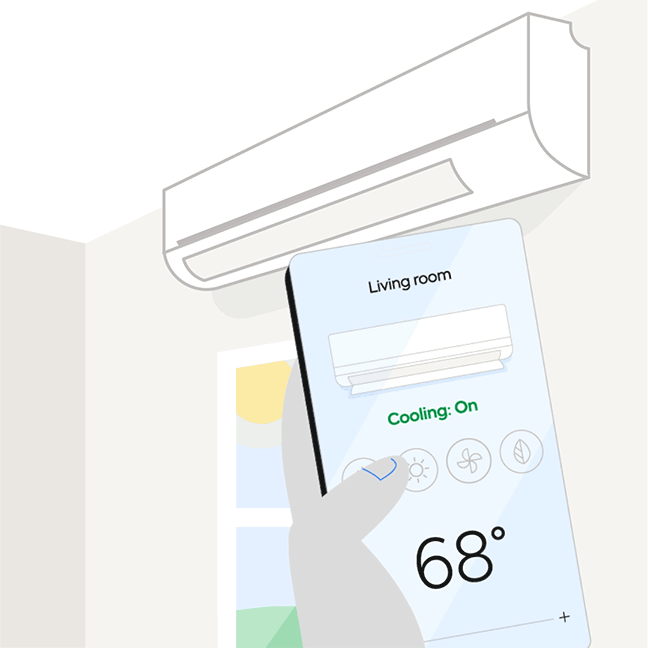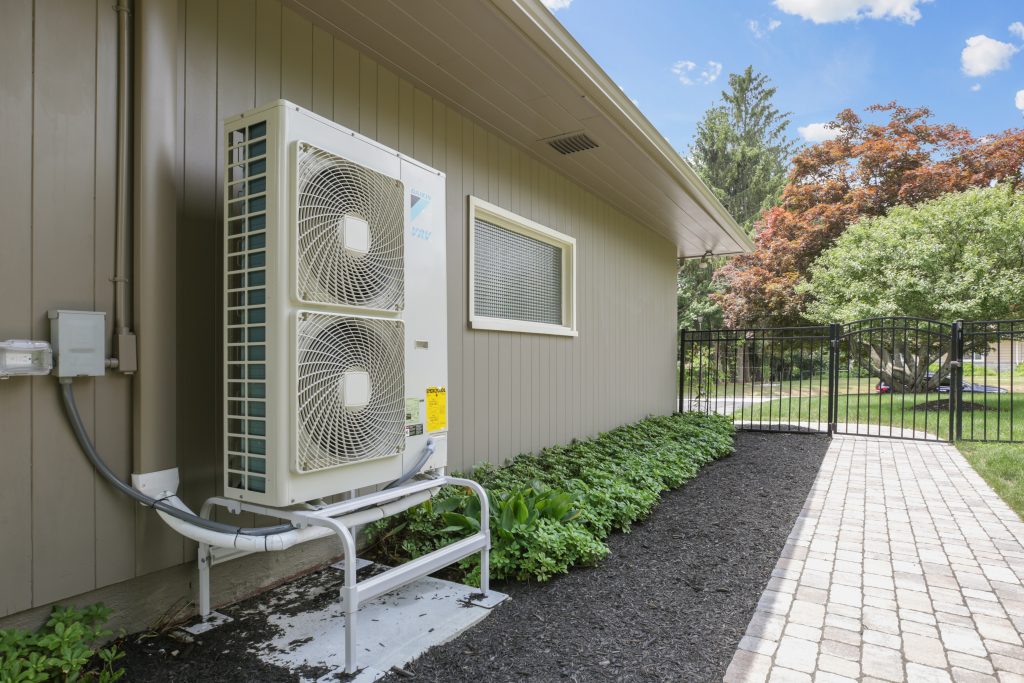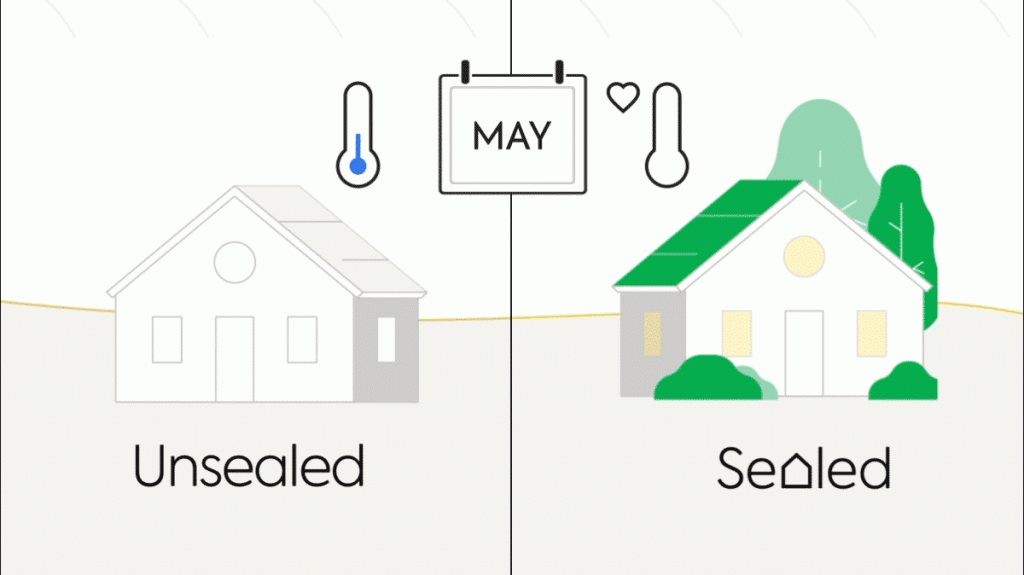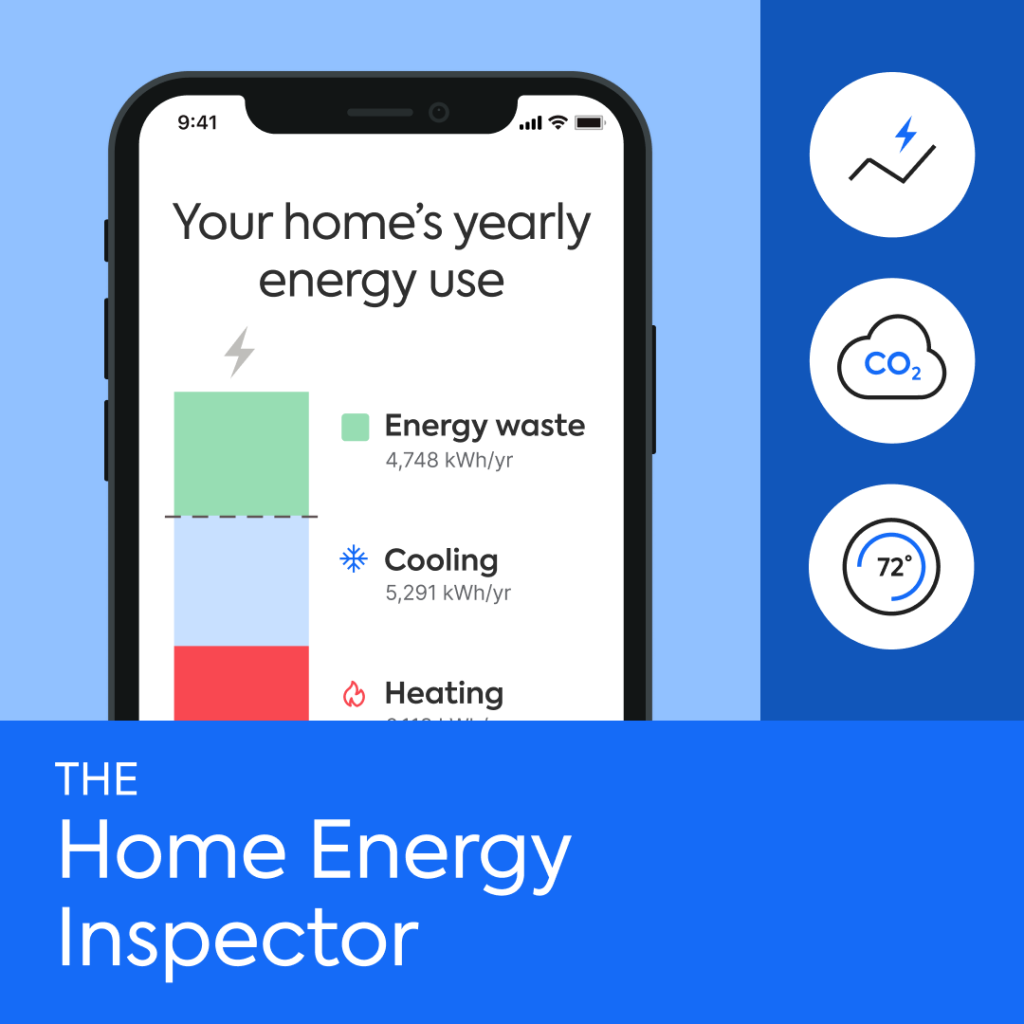High humidity in a house is really uncomfortable—and can be unhealthy, too. Learn the symptoms and how to stop it.
If your house feels more like a sauna than a living space, you’re far from alone.
High humidity levels are a problem in many US homes, especially during hot summer months. And all that heavy, moist air can lead to some really unpleasant problems—like mold growth, poor indoor air quality, and wood rot.
So why is your house so humid? And what can you do about it?
As it turns out, you can do a lot. And whatever the specific causes of your home’s humidity issues, there’s a straightforward two-step fix that will drastically reduce humidity and make your house feel comfortable and fresh year round. In fact, depending on where you live, you could qualify for these home upgrades for $0 upfront cost. Tap here to see if you qualify.
Here’s what this troubleshooting guide will cover:
- Why humidity is too high in your house in the first place
- How to permanently lower the humidity inside your house
- Why your HVAC or AC unit is an important key to addressing high humidity
- The BEST air conditioner and HVAC system for high humidity in your home
- Why sealing and insulating your home can drastically change the humidity levels in your home
- How to fix your humidity problem for no upfront cost
- FAQs about home humidity
Ready to finally live in a comfortable house—one that doesn’t feel sweaty, muggy, and sticky?
Let’s fix your humidity problem.
Learn how you can get humidity-fixing home upgrades at no upfront cost if your house qualifies.
Here’s what causes high humidity in a house
First, let’s be clear: Technically, there are a lot of reasons why your home might be humid. But the truth is—there are only a couple of practical reasons why your house is humid:
- Your house isn’t keeping humid outdoor air outside.
- Your HVAC system isn’t up to the job of reducing your home’s humidity.
If you Google around, you’ll find lots of complex causes for high-humidity indoor air.
One obvious one is the outside climate—hot, muggy weather outside can cause excessive moisture and create a stuffy house with stale, sticky air.

Humidity can also come up through the soil, especially if your house is near a lake or river.
And excess moisture from cooking, bathrooms, appliances, and showers can also raise the moisture levels in your home.
The list goes on.
There are plenty of potential causes of moisture issues in your home, but reading about those usually isn’t very helpful for troubleshooting.
(You probably already know this, though, or you wouldn’t be here reading our guide.)
Next, we’re going to dive deeper into the two underlying reasons your house feels humid:
- Outside air is coming in and
- Your air conditioning or HVAC system is unable to remove excess moisture (like it’s supposed to)
But depending on where you live, with Sealed you can get home upgrades that that fix these problems—and at no upfront cost, too.
Reason 1: Your house isn’t keeping outside air outside.
A house has a few important jobs, but one of the most important is keeping the weather outside from getting inside.
If your house isn’t doing that, it’s likely that its building envelope isn’t up to par.
What’s a building envelope? (Well, we’re glad you asked.)
The building envelope is the boundary—which is why it’s also sometimes called a thermal barrier or thermal envelope—that separates the inside of your house from… well, whatever’s going on outside.
Check out the video below for a good visual of how this phenomenon works.
If there are holes in this boundary—or if it was never properly constructed in the first place—humid air can come into your house and make it feel really, really uncomfortable.
And unfortunately, there are holes and leaks in your house’s thermal boundary—lots of them.
In fact, according to Energy Star, air leaks alone can account for 25–40% of your home’s energy waste (1).
If your home has an insufficient thermal boundary, excess humid air enters into your house from outside and makes it feel really, really uncomfortable.
How will you know if the thermal envelope is part of your humidity problem?
Most houses in the US are full of air leaks. So if you’ve never had your house sealed, there’s a high chance that the open gaps and seams in your house are a major contributing factor to your humidity problem (especially if your house is older).
Want to check for sure? It’s easy to do a DIY air leak check in your home.
Our master bedroom is now the same temperature as the rest of the house…. I couldn’t be happier with the experience and would highly recommend Sealed.
—Peter V., Sealed customer
Reason 2: Your HVAC system isn’t up to the job.
This is the big one. If your home feels suspiciously like a jungle, it’s time to consider whether your HVAC system is up to the job of keeping your house dehumidified.
If your air conditioner is old or outdated, it’s likely struggling to keep your home feeling cool and fresh.
Having an AC system that’s too old isn’t the only potential issue, though.
An improperly-sized AC unit can also contribute to the humidity problem—an air conditioning system that’s too big, for example, will cool the air too quickly without removing enough moisture.
There are lots of ways AC can go wrong. But in all of the cases, insufficient HVAC leads to poor home ventilation—which then leads to a home that feels damp, stuffy, and gross. Yuck.
How will you know if your HVAC is part of the humidity problem?
This one is pretty simple. A properly-sized and well-functioning AC system should make your home feel fresh and cool.
So if your air conditioning system is well-maintained and running and your home is still hot and humid, that’s a pretty good indicator that your AC unit isn’t up to the job.
Another thing to keep an ear out for is short cycling, which is when your AC equipment repeatedly turns on and off in a short burst.
It’s usually a sign that your AC equipment is too large for your space, and that it’s cooling the air so quickly that it doesn’t have enough time to fully dehumidify the air in your home.
Those are the two major reasons your home is super-humid. And now you’ve officially gotten to the good part—how to fix these issues for good.
Here’s how to lower humidity in a house—permanently

Step 1. Get an HVAC system that’s built to handle the humidity
The single most important thing you can do to reduce humidity in your home is to upgrade your HVAC and air conditioning system to one that is designed for your home and can handle the challenge of high-humidity air.
Upgrade your HVAC at no upfront cost.
And, look, we get it. It’s tempting to try to deal with the issue by purchasing small, stand-alone dehumidifiers.
(Although if you have a basement in a wet area of the country, a stand-alone dehumidifier can be a big help.)
Cleaning stand-alone dehumidifiers is a pain. It can be almost impossible to get the mold and mildew out of a unit that’s been running for a while.
But using smaller dehumidifiers will just add to your electric bill without fixing the real problem of poor ventilation—a problem that will need to be addressed sooner or later, dehumidifiers or not (especially if you care about keeping mold and mildew out of your home).
Also worth mentioning: Cleaning those stand-alone dehumidifiers is a royal pain.
It can be almost impossible to get the mold and mildew out of a unit that’s been running for a while. (Don’t ask us how we know.)
In contrast, while replacing your air conditioning system might sound intimidating, there are convincing reasons to consider it.
- A well-designed HVAC system will actually fix the problem. (Sounds simple, but we can’t think of anything more important.)
- Upgrading to the correct HVAC is much more energy-efficient than running a bunch of smaller appliances at the same time as your current HVAC. All those electricity upcharges add up! Which leads us to…
- In the long term, fixing the real problem is a far better value for your money, time, and mental resources. If you try to piecemeal a solution without solving the real ventilation issue, you’ll end up in a spiral of never-ending purchases and annoyances. Our best advice: Fix the problem so it stays fixed.
- If your home is eligible, you can get a new HVAC system installed by experts for little or NO upfront cost. See if you’re eligible here—it only takes two minutes.
The big question here is, of course, what kind of HVAC or air conditioning system is going to be the best at making your house feel cool and clean?
We’ve parsed the research, and there’s a clear winner.
The best HVAC system for high humidity? An air-source heat pump.
Never heard of a heat pump? Allow us to introduce you: Heat pumps are a more advanced and smarter approach to cool and dehumidify your home—and, yes, heat—your house.

Despite their name (sorry, we didn’t invent it!), heat pumps don’t create heat. Far from it. Heat pumps work by transferring heat energy.
In the winter, they transfer heat from the outside air to the inside of your home.
And, in the summer, they reverse the process by transferring heat from the inside of your home to the outside.
Not only does a heat pump cool your home in the summer, but it also pulls moisture out of the air, making it an ideal solution for homes in humid climates.
Read Heat pump vs AC to learn more about the pros and cons. Or learn how you could get a heat pump at no upfront cost.
And, because it’s so efficient, it can drastically cut your energy waste.
In fact, upgrading to a heat pump is one of the best ways to reduce your energy waste at home (see more ways to cut your carbon footprint here).
Basically, heat pumps are the superheroes of the HVAC world (or, as we like to call them, the Tesla of HVAC).
Heat pumps can heat, air condition, dehumidify, and filter the air in your home. You can install them just about anywhere, since some models don’t require ductwork (though heat pumps can also use existing ductwork).
They’re also super-quiet and don’t smell. They run on clean, non-combustible energy.
Plus, they heat and cool evenly—so every part of your home feels exactly the way you want it to. Learn more about heat pumps at The Ultimate Guide to Heat Pumps.
In short: You’re going to like your heat pump much better than your old air conditioning.
We’ve installed a bunch of them, and our customers love them. But don’t just take our word for it.
81% of people say their comfort at home improves after installing renewable-based heating systems, like heat pumps.
2022 report by the European Environmental Bureau
and CoolProducts
Heat pumps make your home feel amazing, and they’re the best option currently available.
Trust us—we’re HVAC nerds. When better HVAC technology shows up, we’ll be the first to let you know.
Even better: If your home is eligible, you can opt to get a new heat pump system for no (or very little) upfront cost. Find out if your home is eligible.
Okay, so better HVAC is the most important thing in reducing humidity, but to get the most out of an updated system, it’s important to make sure that the air you condition stays inside your house.
Let’s look at step 2.
Step 2: Keep humid air outside—where it belongs
The second most important thing to reduce humidity in your home is to make sure that as little hot, humid air as possible gets inside your house.
How do you do that?

Get your home professionally air sealed
Remember all those holes in the thermal envelope of your home? When you get your home air sealed, you’ll fill in all the cracks and gaps that allow air exchange with the outside.
This will keep hot, humid air outside, as well as keep cool, filtered, conditioned air inside—where it belongs.
(Learn more about what air sealing is here—or see how you could get air sealing upgrades at zero upfront cost here.)
25–40% of the energy your home uses to keep you and your family comfortable is wasted through air leaks
EnergyStar.gov
Make sure your insulation is up to the job
Insulation is part of your house’s thermal envelope, and, when it’s working correctly, it helps keep air exchange to a minimum.

But if your home’s insulation is old or insufficient—or if there are important sections of your house that were never insulated at all—your house’s ability to keep cool, dry air inside will be severely compromised.
(Proper attic insulation and insulating around your house’s foundation is especially important.)
Long story short: Adding or replacing insulation might be an effective strategy for reducing humidity in your house.
Let’s be clear, though: Sometimes insulation isn’t the best investment. That’s why it’s important to call in an expert.
If you do decide to upgrade your insulation, here are the major types you should know about:
- Fiberglass insulation: Fiberglass is a common type of insulation that’s made from glass fibers. (It’s the kind at the home improvement store you’re probably thinking of!) However, it’s not the best for every situation, and it’s particularly susceptible to moisture.
- Spray foam insulation: This type of insulation that is made from polyurethane. It is sprayed onto surfaces and expands to fill in gaps and cracks. Spray foam insulation resists moisture well and is quite effective at keeping humidity out. Plus, it’s particularly great at sealing the area around your home’s foundation and rim joists.
- Cellulose insulation: Cellulose insulation is made from recycled materials and has a negative carbon footprint. (Neat!) It can absorb moisture in some cases (depending on where it’s used), so you’ll need to get a professional opinion to know if it’s right for your house.
If you’re not sure which type of insulation is right for your home, we’ve got two suggestions:
- Take a look at our guide to attic insulation (it covers attics, but the information is pertinent to all kinds of insulation)
- If you’re eligible—find out here in two minutes—get a home scope from a Sealed expert. It’s completely free to get our professional opinion.
You made it! That’s the basic two-step process to get your home feeling great inside.
Yes, it’s simple, but that doesn’t mean it’s easy.
In fact, neither of these steps are good DIY projects; it takes expertise and years of on-the-job training to design and install the kind of home climate system that will keep a house feeling amazing long-term.
(Luckily, with Sealed, it’s easy to get expert help from people who’ve been doing this a long time. We do all the heavy lifting.)
Ready to get rid of that muggy feeling in your house?
Start with our quick questionnaire. If your house qualifies, you could get a heat pump, insulation, and air sealing at no upfront cost.
(Yes, you read that right!)
Still have questions about high humidity in your house? FAQs are below!
Frequently asked questions about humid houses
Scan the questions below, or use the links to jump ahead to what you need for today.
- What causes high humidity in a house?
- What are the symptoms of high humidity in a home?
- How to lower humidity in a house?
- How humid should my house be?
- What should the humidity be in a house in summer?
- How to control humidity?
- How do I fix high humidity in my house?
What causes high humidity in a house?
High humidity in a house can be caused by many things, but the biggest reason is poor ventilation—in other words, air isn’t being circulated properly, which causes the air in your house to become stagnant and humid.
The other major reason? Too much air exchange with the outside. If your house isn’t properly air sealed and insulated, air from the outside gets drawn into the home—making everything pretty uncomfortable. (This can be a problem in both warm and cold climates, as well as during different seasons.)
What are the symptoms of high humidity in a home?
Here are a few of the most common symptoms of high indoor humidity:
- The air inside your home feels moist and muggy
- There’s mold and mildew growing inside the home
- Watermarks in high-humid areas, like bathrooms, that show lingering humidity is a problem
- You often feel hot and sweaty inside your home
- Your nose gets stuffed up
- You notice moisture and condensation gathering on the inside of your windows
None of these symptoms are pleasant, but—with a few strategic upgrades—you can permanently fix the problem.
How to lower humidity in a house?
If you want to permanently lower indoor humidity, the most important step to take is to fix or upgrade your HVAC so it can handle your house’s air conditioning and dehumidifying needs. You can always try buying smaller standalone dehumidifiers, but trust us: If your AC isn’t working properly, it’ll be difficult to keep the humidity under control. (For more on that, click here.)
Another way to reduce humidity is to seal up your home so that the conditioned air stays inside. This can be done by air sealing and making sure your insulation is up to the job. Fiberglass and spray foam are both effective at keeping humidity out, but it’s important to make sure the structure of your home is well sealed so that heavy, moist air can’t seep through.
How humid should my house be?
What’s a comfortable level of humidity? Most people find a humidity level of between 30% and 50% pretty livable (2). However, it really depends on your individual preferences and climate. If you live in a hot, humid climate, you may prefer a lower humidity level to keep you cool and comfortable.
For a deeper dive, and to learn how to test for humidity levels, tap here to read What should the humidity be in my house?
By the way, there are definitely consequences to letting the humidity in your house get too high for too long. The most common problems are mold growth and condensation on windows—which can cause long-term damage to the property if not corrected. But high humidity can also have effects on you and the inhabitants of your house (think itchy skin and respiratory issues).
Basically, it’s important to get humidity under control in your house.
What should the humidity be in a house in summer?
The optimal level of humidity for most people is between 30 and 50%, according to Energy Star (3). That might sound high, but outdoor levels of humidity can be much higher! For example, Chicago’s average outdoor humidity hovers around 70%. (4). New York is up there, too, with an average relative humidity of about 71%. (5)
How to control humidity?
You’ve got two options—short-term and long-term.
The short-term option to control indoor humidity is to use a portable air conditioner or dehumidifier. These devices can be very effective at reducing the humidity in your home, but they only work while they’re turned on. As soon as you turn them off, the humidity will start to creep back up. (Another annoyance is that you typically need to empty the dehumidifier’s water reservoir every few hours.)
The long-term solution? Upgrade your HVAC system, and you also should air seal and insulate your house, too. This might sound like a big investment, but it will pay for itself in comfort and energy savings. A properly sized and installed HVAC system will keep your home at the perfect temperature and humidity level all year round, especially if your home is properly sealed and insulated.
(See if you’re eligible for upgraded HVAC for no or little upfront cost.)
How do I fix high humidity in my house?
You can try a short-term solution like using a portable air conditioner or dehumidifier, but, really, that won’t fix the problem—it’ll just cover it up. The better, more permanent option is to upgrade your HVAC system and weatherize your home.
If you’ve got humidity issues, we’ve got the fix for you.
Now that Sealed is around, there’s zero reason to tolerate a super-humid house. If your house is eligible, you can get a home upgrade plan from experts with years of experience in climate control and home air circulation.
We don’t do cookie-cutter solutions, either. Your upgrade plan will be based on the unique needs of your house—including the type of materials you’d like to use—and designed to ensure that your house feels amazing. Even on the hottest, most humid day of the year.
We’ll put together a custom plan, hire expert contractors, and make sure the work gets done right. Plus, you’ll get the famous Sealed energy-savings guarantee if your house qualifies.
All you need to do is take a 2-minute questionnaire to get started.

Ready to crunch the numbers?
High humidity is a big sign of energy waste.
Check out our home energy usage calculator to see where you could cut energy waste BIG TIME.